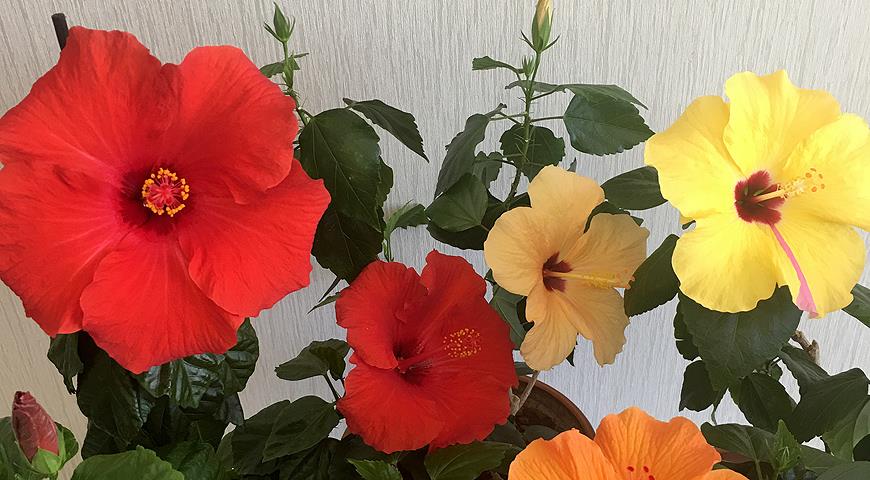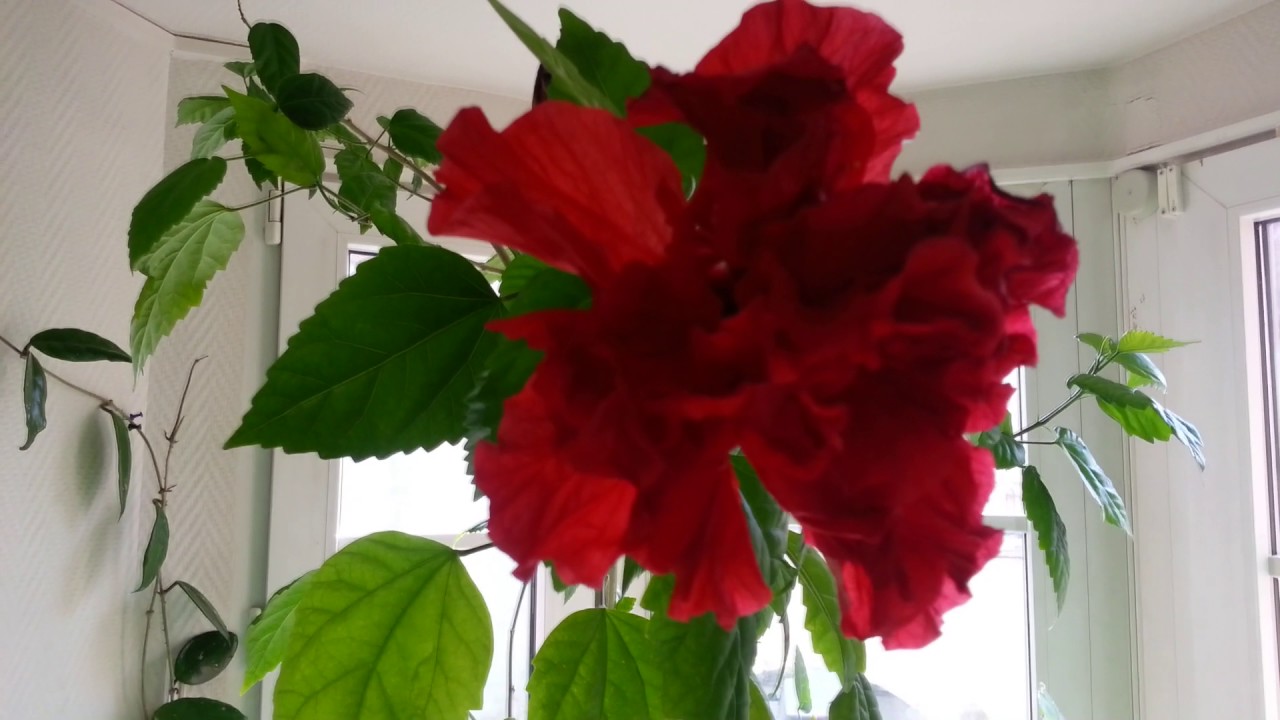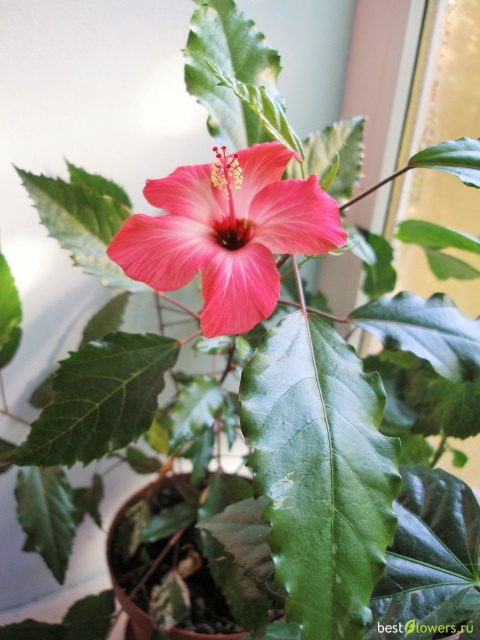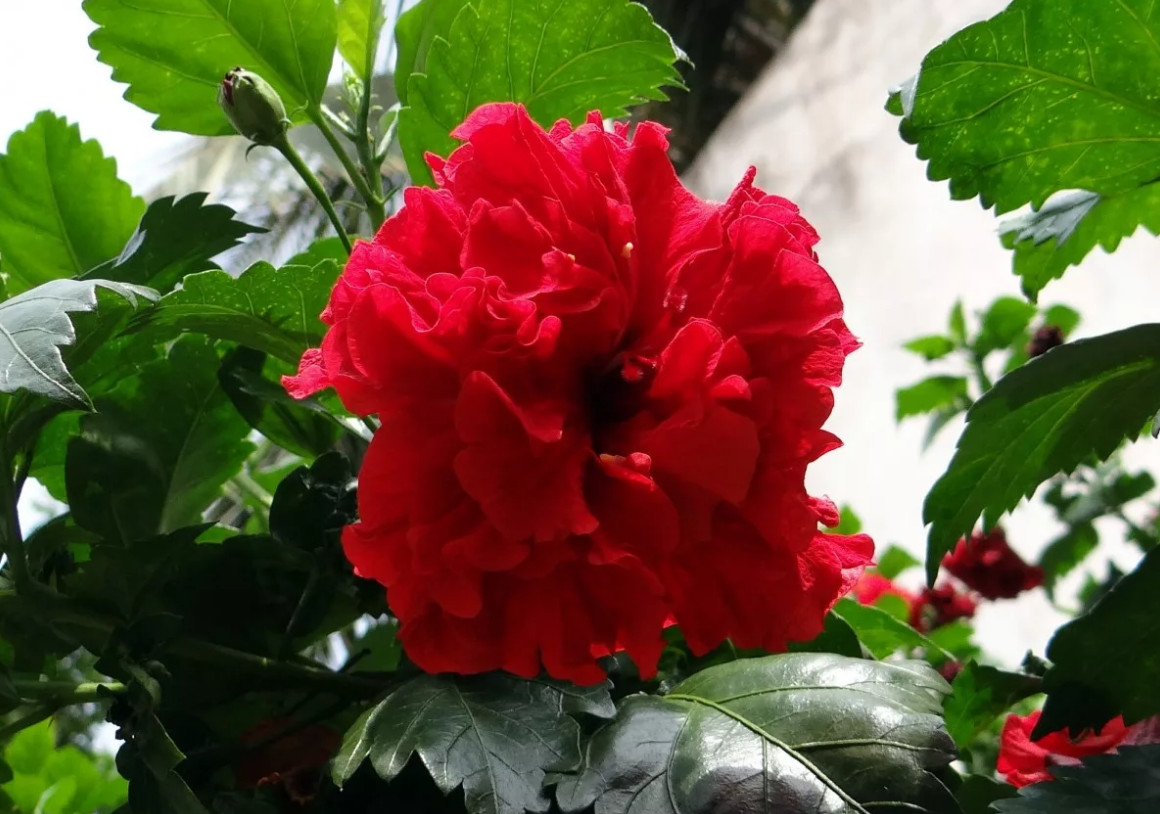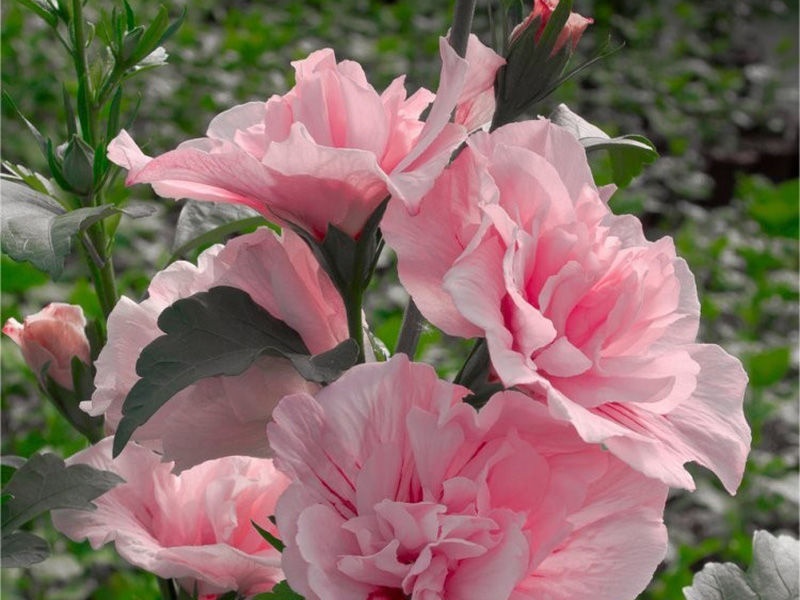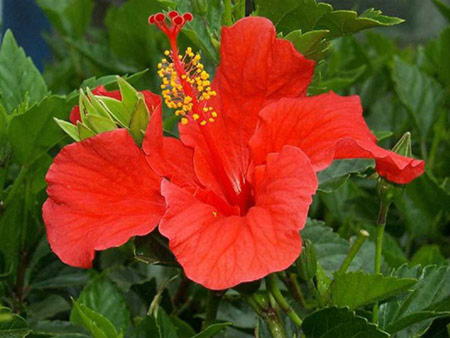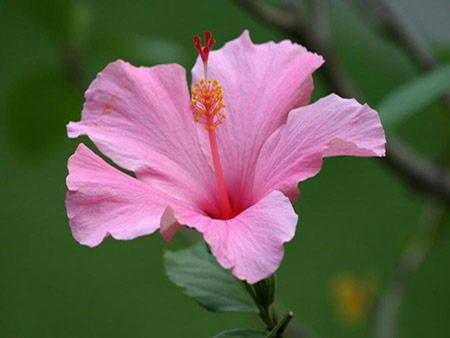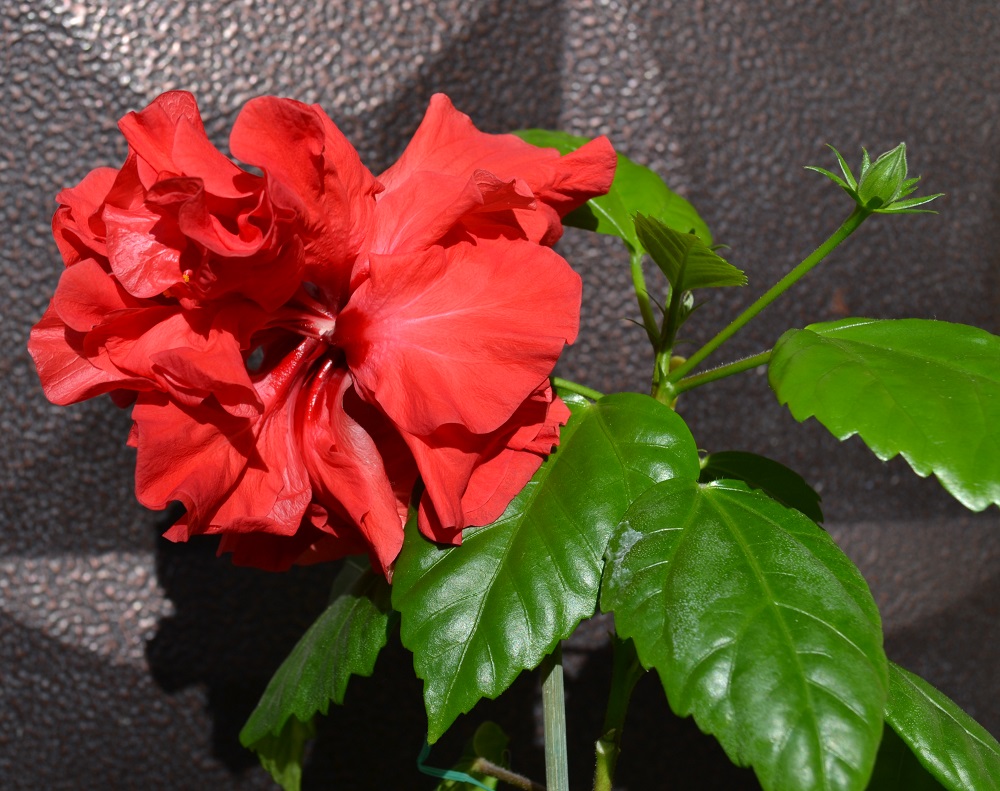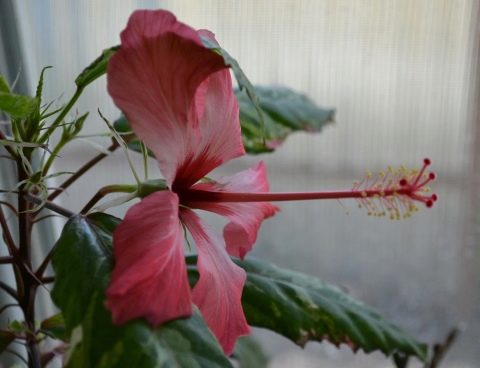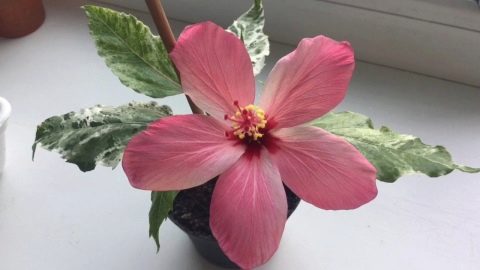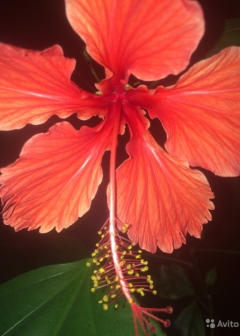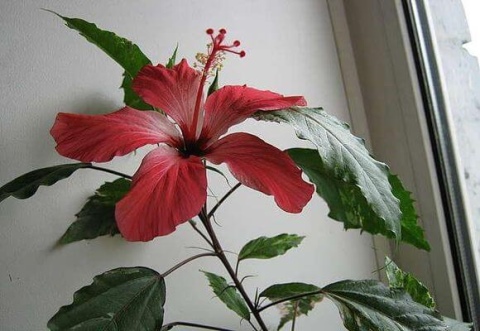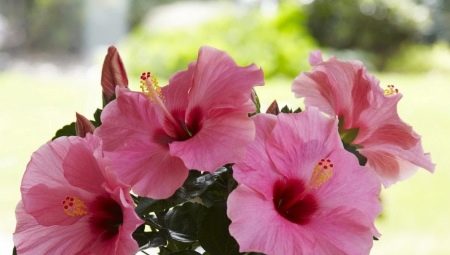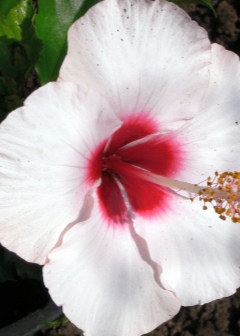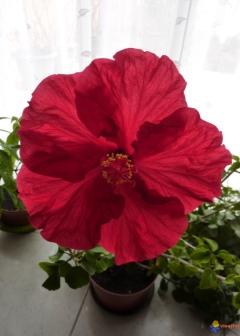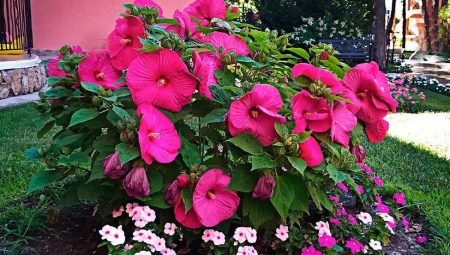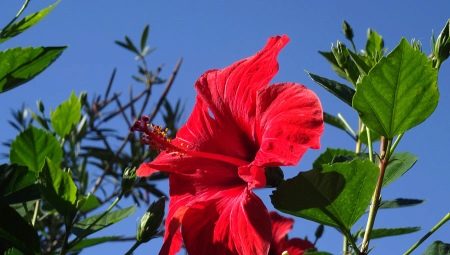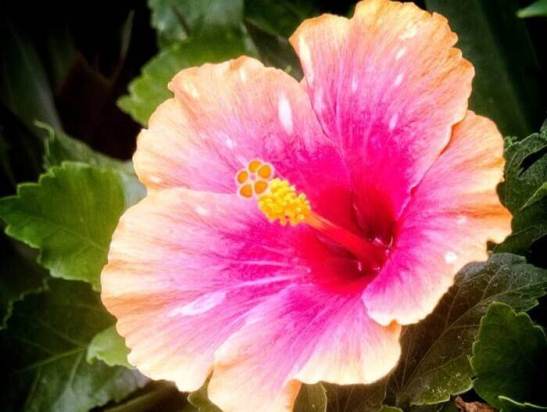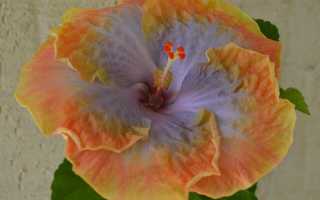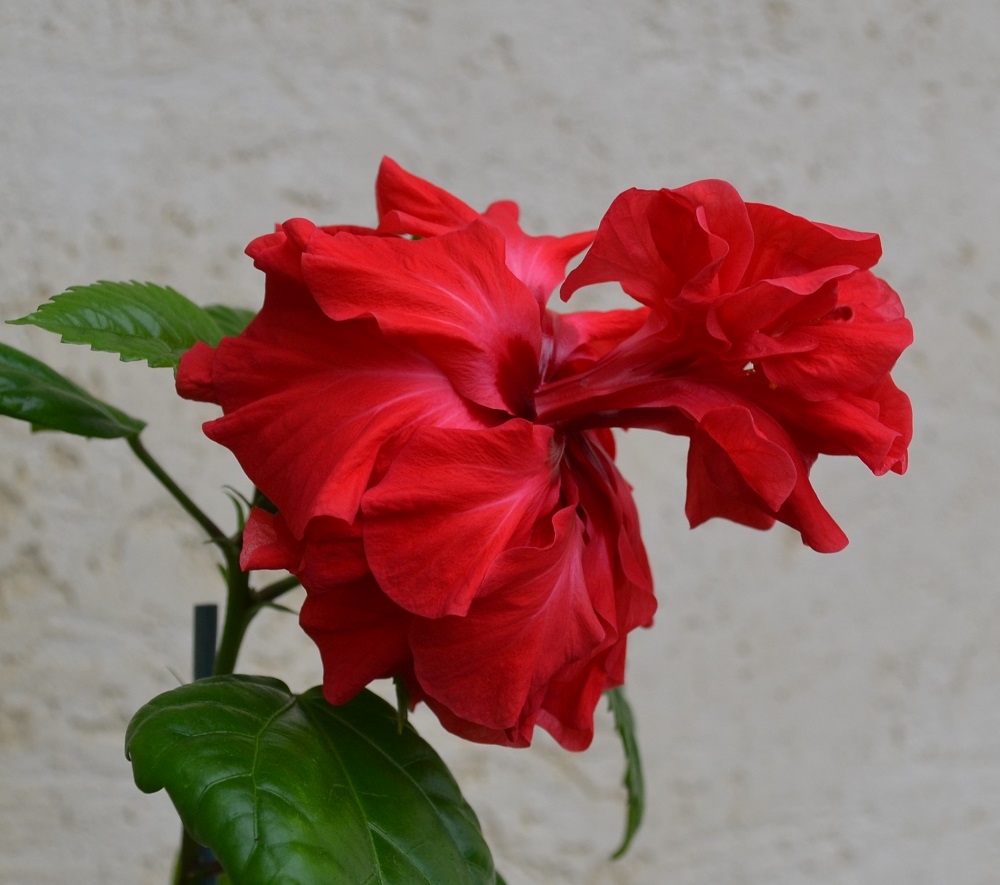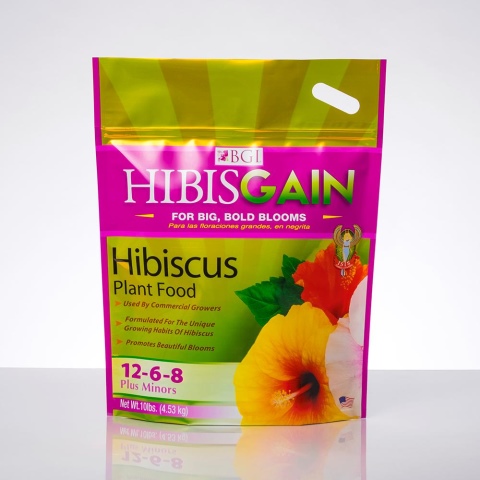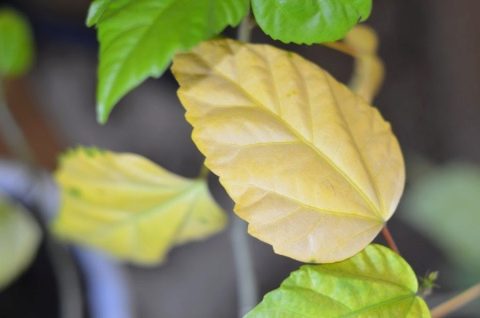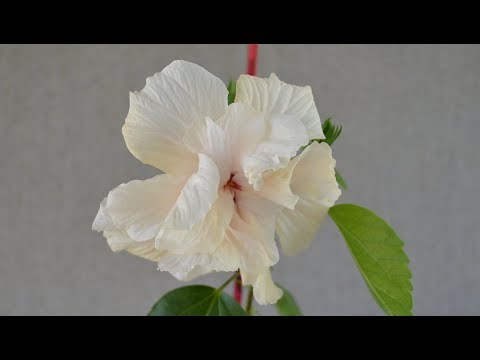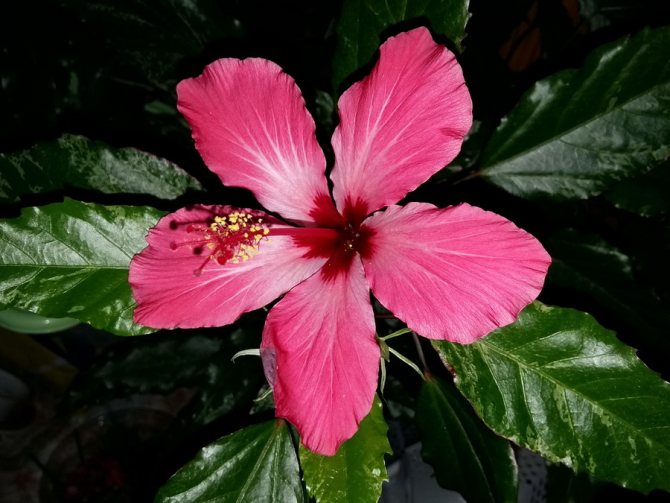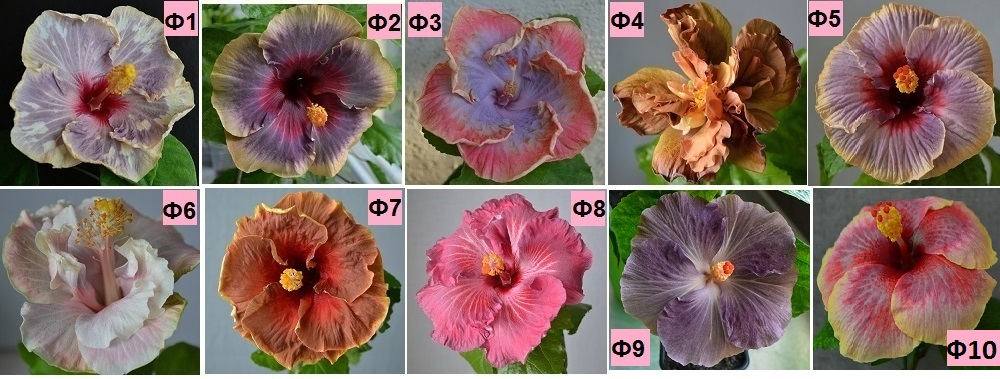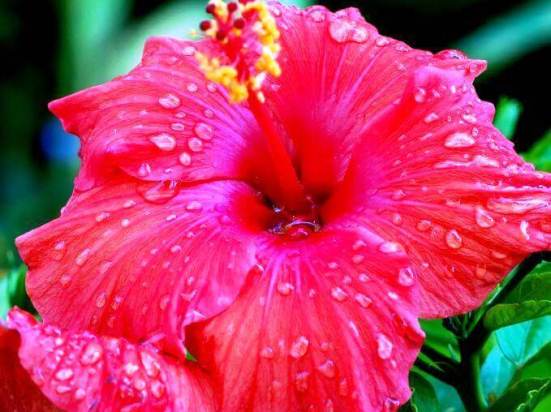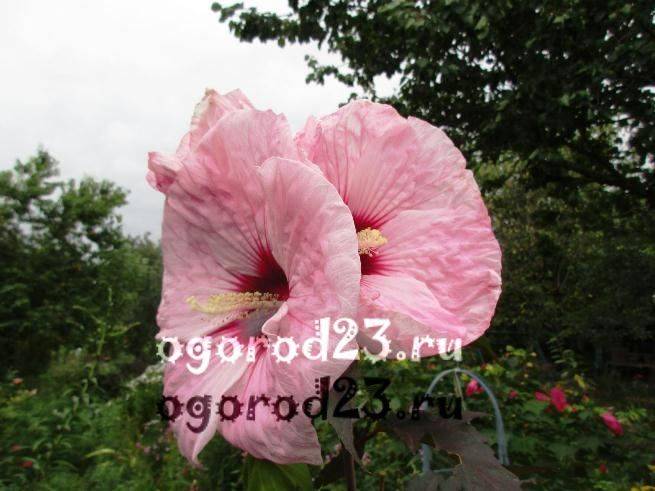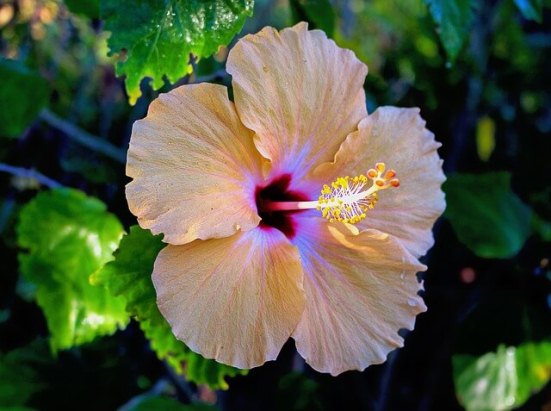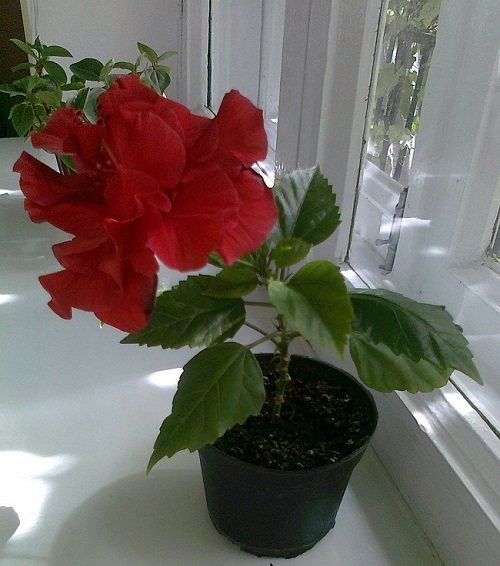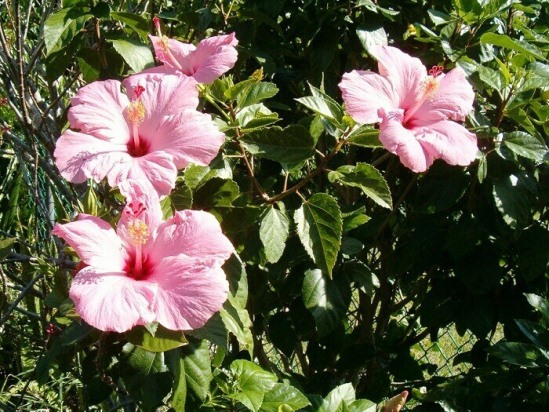Indoor views
Low-growing indoor varieties from 70 cm to 1.2 m have been bred for the house. Hybrid hibiscus blooms quite easily with a combination of care and love with large flowers over 12 cm in diameter. The flowering period lasts all spring-autumn, but the flowers fade quickly. By color, the breeding species cover the entire gamut - from black to snow-white with the most charming combinations. Hibiscus hybrid is distinguished by a wide variety of both varieties and unexpected options for colors, shapes, textures and sizes of blooms within a particular variety. The uniqueness is that the season, the amount of sun, fertilizers, temperature of the content - all this can change the signs of flowers, even one bush, sometimes beyond recognition.
 Exquisite flower content
Exquisite flower content
The existing types of Hibiscus are divided into main groups:
- Dutch;
- American or Florida.
Hibiscus chinese
It is also called the Chinese rose. This domestic shrub has appeared in Europe since the 17th century. The plant is covered with evergreen shiny ovoid foliage with jagged edges. Blooms all summer and autumn. A flower of all shades of white, yellow, red. After flowering, it lives no more than 2 days, but is immediately replaced by newly blossoming flowers. Their diameter reaches 10 -16 cm.
Terry hibiscus
Ideal for at home. The main features of the plant are multi-layered flowers with a large number of petals, which look more spectacular than usual. It is more often found in a deep red color.
Red-leaved hibiscus
Differs in purple leaves, reminiscent of maple. It is characterized by a short flowering from September to the end of October. Unpretentious, grows quickly, which allows you to achieve the desired decorative effect in a short time.
Syrian hibiscus (ketmia)
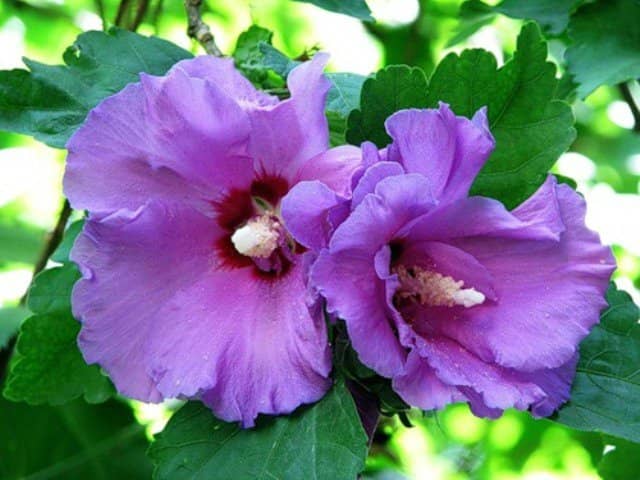 Syrian hibiscus
Syrian hibiscus
The plant is quite large for the home, it is ideal for decorating a winter garden, greenhouse or street as a small tree. Blooms from June to September. Mallow-like flowers are 12 cm in diameter. In addition to the new variety with variegated foliage, frost-resistant species of Syrian hibiscus were bred, capable of growing in less southern regions.
Cooper's hibiscus
This homemade variegated variety is named after Daniel Cooper, who brought it to England from a trip to New Caledonia. The characteristic features of the plant are variegated leaves. In moderate light, they are painted with white, green and pink strokes. When they get enough light, they turn pink completely. The red color of large flowers changes from the edge to the center, decorated with a pistil with an unusual curvature. The variegated species is the most resistant to pests and diseases of those that are grown at home.
Hibiscus Night runner
The Night runner variety received the title of king of all hibiscus thanks to the chic coloring of large flowers measuring 18 - 22 cm.On the lush Night runner bush with small leaves, they stand out for their royally rich color: around the white-pink eye there is a wide border with alternating red, blue-blue , coral pink flowers. The wavy edges of the petals end with a yellow stripe. Like all Floridians, the Night runner likes diffused bright light, but without direct sunlight.
Mix
By planting not one plant in a home flower pot, but several with leaves or flowers of different colors, you can get an unusual mixed composition of indoor hibiscus. She will become a wonderful decoration for any home.
Wherever hibiscus grows, it is a clear favorite, bringing with it unforgettable signs of a bright tropical sun.
Growing conditions
Sour hibiscus needs moist but well-drained soil, although it tolerates drought well. Container plants need to be watered daily. The location in our area requires a sunny one. Weakly acidic loams (or better sandy loams) of the Moscow region are well suited for this plant, especially fertilized ones. An important point is protection from winds that can ruin the stems.
The plant blooms in August, when the days get shorter, and is able to bloom for several weeks. Flowers are open for several hours during the brightest time of the day, from noon. Each flower lives for one day. But still, we should consider it more as a bright decorative deciduous plant for mixborders, since some varieties are not capable of flowering at all.
The plant is resistant to nematodes, so it can be safely planted where ornamental and vegetable crops susceptible to this pest previously grew - for example, tomatoes and other nightshades. In hybridization, this species is often used to impart nematode resistance to other hibiscus.
Botanical description
- Other names: Crazy Rose (rosa loca), Lotus tree.
- Latin name: Hibiscus mutabilis.
Origin story
Southern China is considered the birthplace of the Changing Hibiscus, where for centuries it has been widely used in folk medicine, as well as in the manufacture of natural dye, ropes and ropes. In medieval China, flowering hibiscus acquired a cult status, “responsible” for strengthening marriages and prospering businesses.
At the end of the 18th century, the changeable hibiscus first appeared in Europe, and a little later in Russia. The flower began to quickly gain popularity around the world due to its relative unpretentiousness and impressive appearance.
Hibiscus has been cultivated as a houseplant since 1831.
Appearance
In natural conditions, Hibiscus Variable has a height of about 3-4m. Annual growth is 35 cm in height and 35 to 40 cm spread.
- Umbrella crown.
- Erect branched trunk, leaves are arranged on long thin petioles, drooping almost vertically with age.
- The leaves are large, velvety (about 25x25 cm), dark green, maple-shaped, with jagged edges.
- Flowers can be from 5 to 30 centimeters in diameter.
- Hibiscus fruits are small capsules that split into five leaves. Inside - fibrous or fluffy seeds.
At home, hibiscus has a height of 50 cm to 3 meters. Great for making bonsai.
Habitat geography
In cold climates, Hibiscus mutabilis grows with great difficulty (most often as a houseplant).
Outdoors, it grows freely in tropical regions of China and Asia, America, Brazil, Africa, and the Middle East.
Interesting fact! Hibiscus Changeable (crazy rose) got its name because of its petals, which gradually change color from pale cream to purple during flowering.
Tree hibiscus
A photo in the garden with this exotic plant looks great. Although hibiscus grows slowly, many gardeners are eager to grow it. Under natural conditions, it can reach 3 meters in height with a width of about 2.5 meters. In garden culture, it is a small bush or standard tree up to 2 meters high. Rigid, straight and slightly branched hibiscus shoots are covered with serrated leaves of a dark green color. They appear on shoots in late spring.

A distinctive feature characteristic of many varieties of garden hibiscus is the late flowering time, which occurs from the end of July to October inclusive. This feature and the exotic appearance of the flowers contributed to the fact that this plant in many gardens and personal plots became a real miracle of the outgoing summer. Treelike hibiscus is quite common among gardeners. Photos of this beautiful plant can be seen in many gardening sites and magazines.
Quite large flowers that form on the shoots of the current year can be double, half double, simple, with wavy petals at the edges, two-color or monochromatic, with an eye in a contrasting color. It all depends on the type of plant.
To get a beautiful hibiscus in the garden, it is important to prepare very carefully for planting it. It is necessary to purchase good seedlings of this plant, choose the right place for planting on the site
Care should also be taken to properly prepare the soil for this luxurious exotic miracle of nature.
Reproduction
Cooper's hibiscus propagates using cuttings or stems. The best breeding periods for variegated hibiscus are February to March and July to August. For rooting cuttings, you can use water or a sand and peat mixture. A greenhouse is organized for the cutting - it is covered with polyethylene or placed under glass. After 3 weeks, he sprouts.
Taking care of a Chinese rose is within the power of people taking their first steps in floriculture. The plant gratefully responds to care with beautiful flowering and lush bright foliage.

Hearing the word "hibiscus", flower growers do not immediately understand which plant they are talking about. They know it by a different name: the Chinese rose. This member of the Malvaceae family grows as a bush, tree or herbaceous modification. It is found in the wild on almost all continents. Thanks to the efforts of breeders, flower lovers have the opportunity to breed it at home.
Reproduction of garden hibiscus
How to propagate hibiscus
As you can see, both planting and caring for hibiscus is within the power of even novice growers. The reproduction of hibiscus, and the care of it after reproduction is just as simple. Garden hibiscus (Syrian) propagates by layering, grafting, but most often by cuttings and seeds. Hybrid hibiscus propagates by dividing the bush, grafting, and green cuttings.
In the photo: Orange hibiscus
Hibiscus from seed
Growing hibiscus from seeds begins from January to March. Before sowing, hibiscus seeds are soaked for half an hour in a dark pink solution of potassium permanganate, and then for a day in a small amount of epin solution, so that the seeds are barely covered with it. After that, the seeds are sown in containers with a mixture of sand and peat, covered with glass and placed in a warm place, where the temperature is kept within 25-27 ºC, it would be nice to arrange a bottom heating container with sowing.
It is also necessary to regularly ventilate the seed container, remove condensation and moisten the substrate.
When the first leaves develop at the seedlings, they are planted in personal pots. Make sure that the seedlings do not stretch: if they lack light, you will have to arrange artificial lighting for the seedlings. In open ground, hibiscus seedlings are planted in mid-May. Strong specimens can be planted immediately to a permanent place, and weaker ones are planted for growing on a training bed at a distance of about half a meter between specimens. Garden hibiscus, unlike hybrid hibiscus, also propagates by self-sowing.
Propagation of hibiscus by cuttings
For vegetative propagation in the summer, cuttings of hibiscus with two or three internodes are cut, the lower sections of the cuttings are treated with a growth stimulator, then they are planted in greenhouses with a peat substrate and lower heating is organized. Rooting of hibiscus takes place within a month, after which the cuttings are transplanted into pots with leafy soil, peat, turf and sand in equal parts, watered regularly, and when new shoots grow up, they are pinched to stimulate tillering. As soon as a bush is formed, it is transplanted into open ground, and if there is decent care for it, the hibiscus from the cutting will bloom in the first year after planting. Experienced growers manage to root hibiscus cuttings not in the ground, but in water.
In the photo: Large hibiscus flower
Pests and diseases of hibiscus
Harmful insects and diseases of hibiscus
Hibiscus is rarely affected by insects and diseases, but if it suffers from a lack of moisture for a long time in dry weather, it can be occupied by thrips, aphids, whiteflies and spider mites. To eliminate pests, you will have to resort to double treatment of the plant with insecticides Aktellik, Fitoverm, Inta-vir, Karbofos at intervals of a week or ten days.
Of all the known diseases, chlorosis most often affects hibiscus in the garden - the lower leaves of the hibiscus fall off, and the new ones grow yellowish. This happens due to a lack of nitrogen and iron in the soil, therefore, iron chelate should be added to the water for irrigation, and in the spring, do not forget to apply a complex mineral fertilizer containing nitrogen to the soil.
Photo: Growing hibiscus outdoors
Hibiscus turns yellow
Hibiscus leaves turn yellow from chlorosis, as well as in case of trauma to the root system, which the plant could receive during transplantation. If the hibiscus turns yellow due to the roots, then it is necessary to add Zircon or Kornevin to the water for irrigation (see instructions) and for spraying the leaves (three drops per half liter of water). Hibiscus leaves turn yellow as a result of insufficient watering in hot dry summers.
Hibiscus does not bloom
If you have planted a hibiscus in a bright, spacious area and take care of it, as required by agricultural technology, but nevertheless it does not want to bloom, most likely it is a lack of phosphorus and boron. And if the shoots have slowed down their growth, then the problem is also a lack of nitrogen. Do not forget to apply the fertilizers necessary for the hibiscus on time, and it will definitely bloom.
Hibiscus leaves fall
If hibiscus leaves fall off in autumn, this is a natural process, but if this happens prematurely, then the problem has arisen either due to improper watering (insufficient or excessive), or the root of the plant is injured. For advice on how to deal with these cases, see the previous sections.
In the photo: Hibiscus in a flowerbed
Description of the plant
Hibiscus is a plant of the Malvov family. The name "variegated" is a reflection of the peculiarities of its color. In bright light, the leaves acquire a variegated color, combining greenish, white, red shades. Their appearance can change not only depending on the illumination, but also on the composition of the soil and other growing conditions.
Variegated hibiscus has a second name - Cooper's hibiscus. His plant received in honor of Daniel Cooper, who first introduced him to Europeans. And the hibiscus itself comes from southern China. In Latin it is called Hibiscus rosa-sinensis var. Cooperi. Currently, the area of growth covers Indonesia, Sumatra, Sri Lanka and the Hawaiian Islands.
At home, variegated hibiscus feels great and can live up to 20 years. Florists often call it the Chinese rose because of its beautiful inflorescences, reaching 12 centimeters in diameter. Flowers can be double or regular. Cooper's hibiscus has many varieties, and they all have different petal colors and flower shapes. Most often, inflorescences are painted in bright red or pinkish shades. Types with orange and yellow petals are popular.
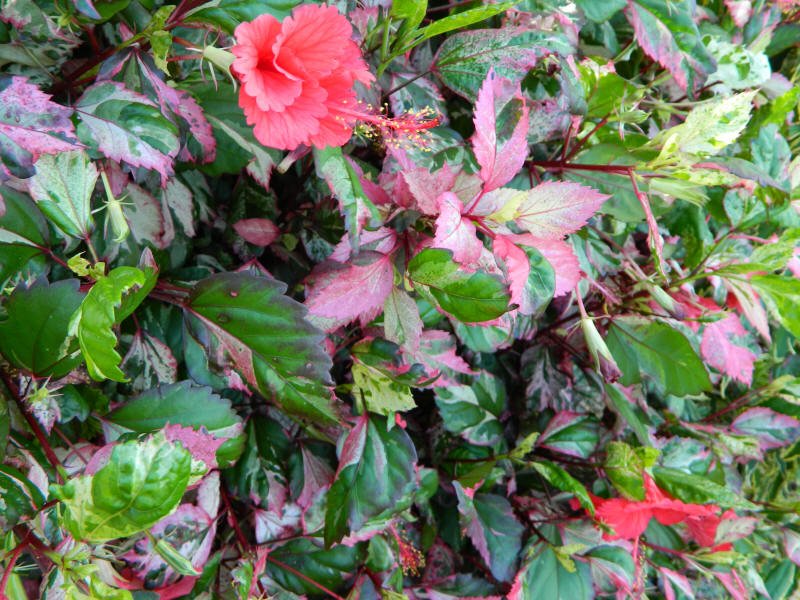
Flowering usually occurs between March and October. But at home, with favorable maintenance factors, plants are able to give abundant flowering in winter. The inflorescences have a short lifespan - they begin to fade 1-2 days after they bloom. But since new buds and petals are constantly appearing on one bush, the effect of prolonged flowering is created.
In place of the inflorescences, fruit-boxes are formed, inside which a large number of seeds covered with fluff ripen.
The leaves of this variety of hibiscus amaze with a variety of color combinations. Moreover, completely green leaf blades and yellowish, white and red transitions can be combined on one plant. All of them are covered with bizarre patterns. The size of the leaf can reach 15 cm in length and 6–7 in width.
Variegated hibiscus is a tall plant. Even with room maintenance, its height often exceeds 100-120 cm. Florists form lush crowns in domestic specimens. This can be done due to the fact that they respond well to pruning, grow quickly during the growing season and give side shoots. Bloom begins in the year of planting.

Large assortment of varieties
To date, it will not be difficult to purchase terry hibiscus seedlings, because they are offered by many private gardeners and professional nurseries with plants. Below we will consider the most popular and beautiful varieties.
Duc De Brabant. It is considered one of the most abundant flowering hibiscus varieties. When planted in a garden, it grows from a bush into a tree, on which luxurious crimson flowers flaunt. Blooms all summer long, hardy. The leaves of this variety are similar to those of chrysanthemums.
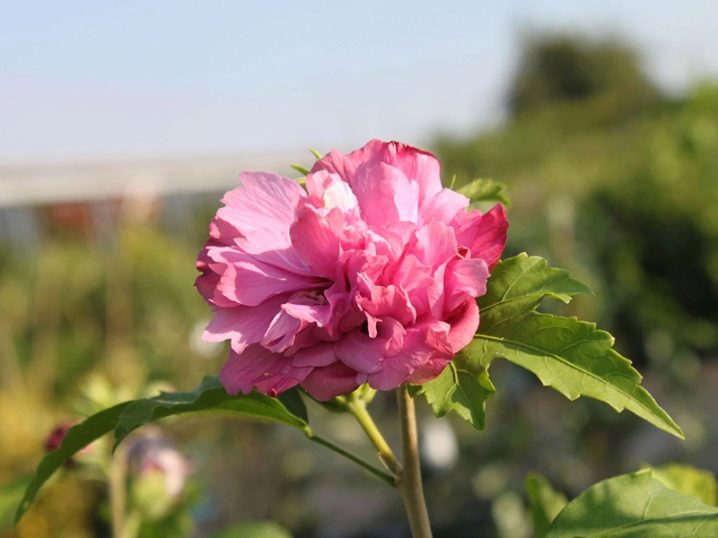
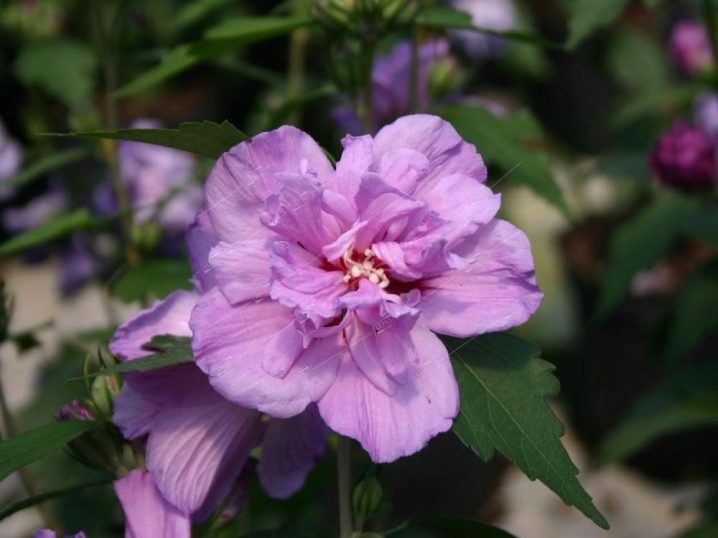
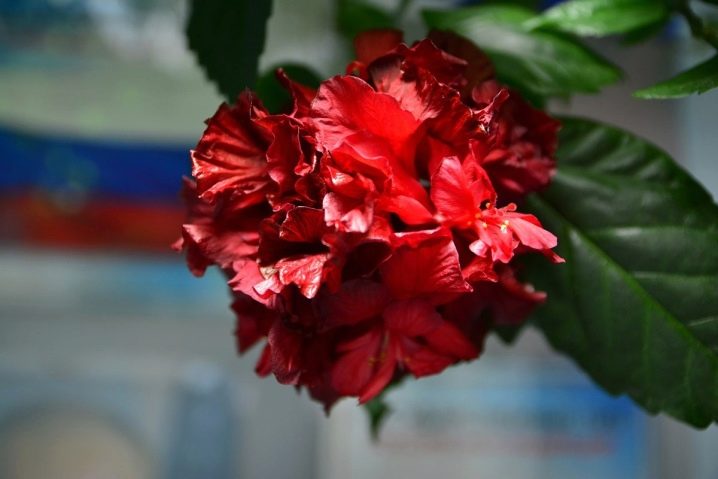
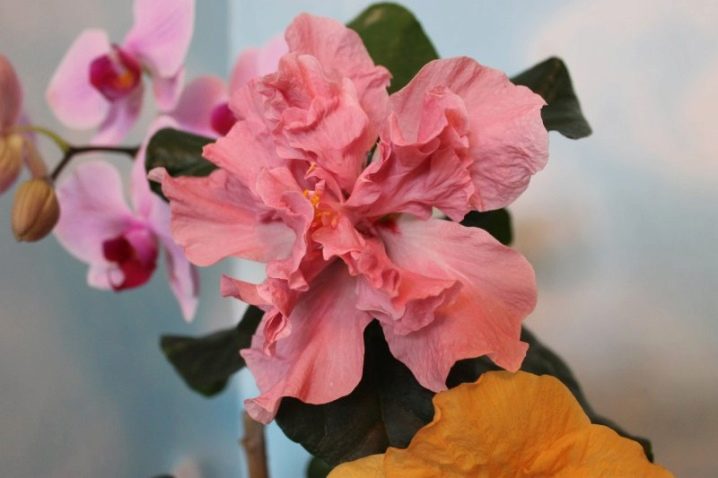
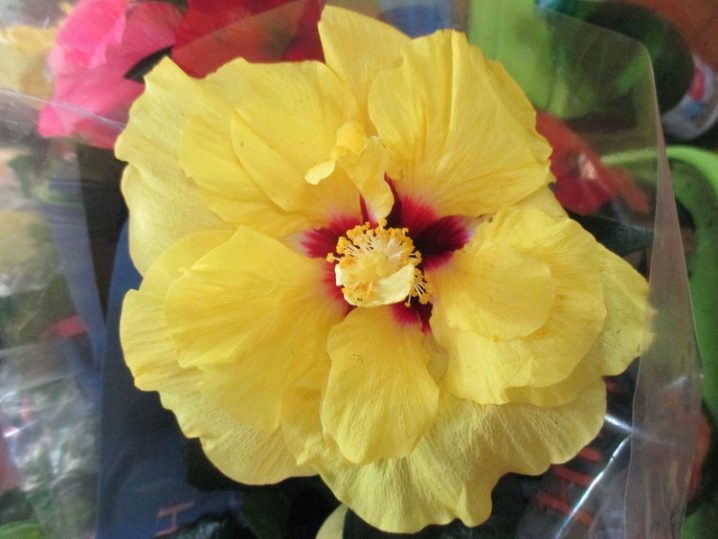
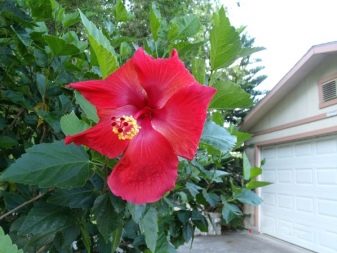
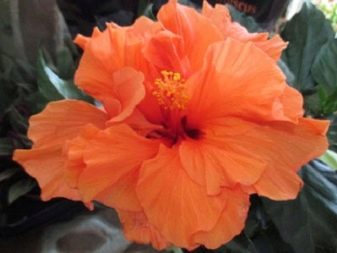
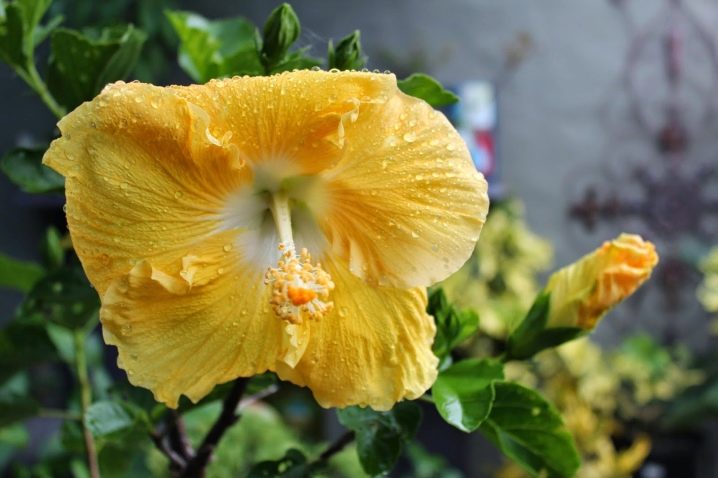
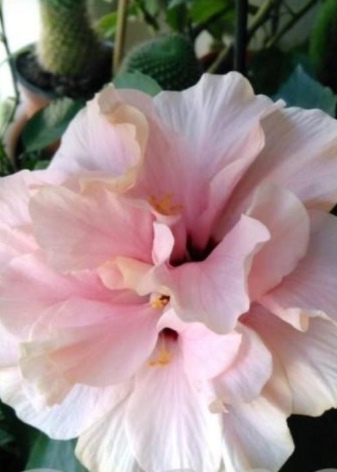

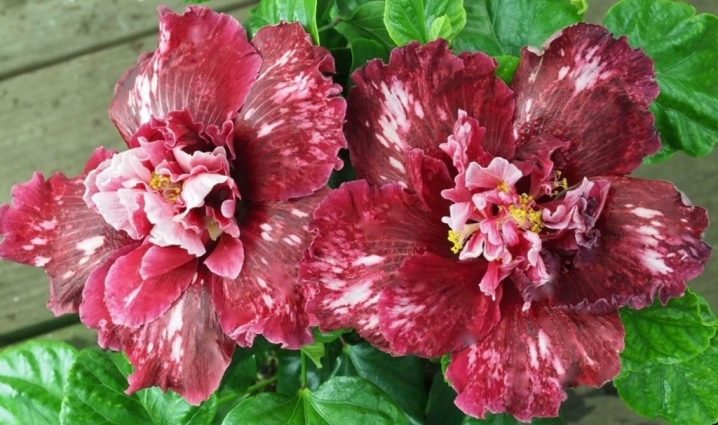
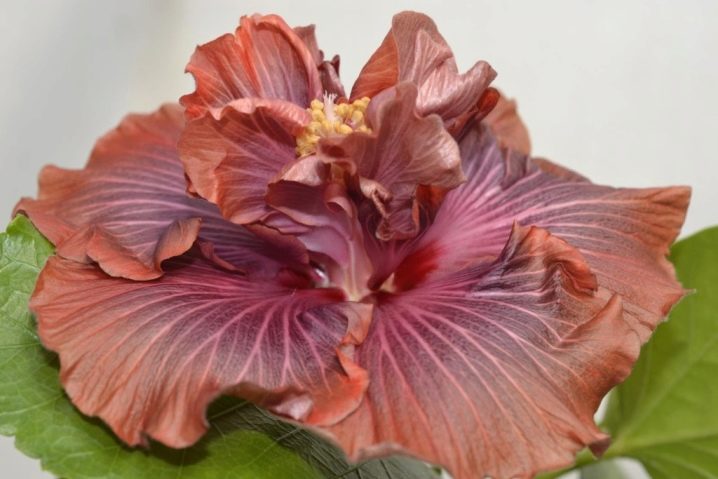
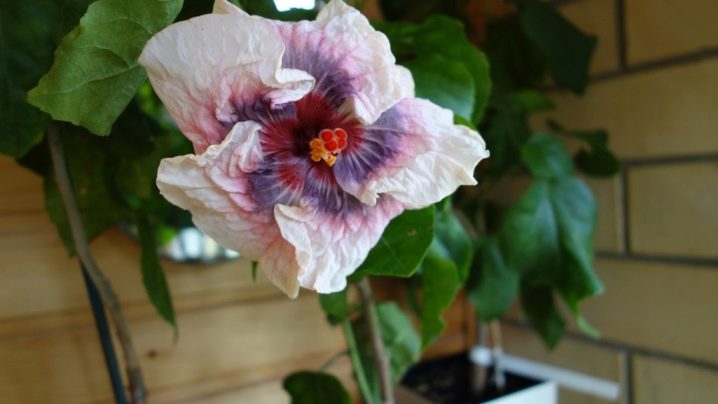
We also recommend paying attention to the following varieties of terry hibiscus, which can interest potential lovers of unusual flowers. Most of the varieties are Taiwanese and selective, however, they take root in our country without unnecessary problems: Passion;
Passion;

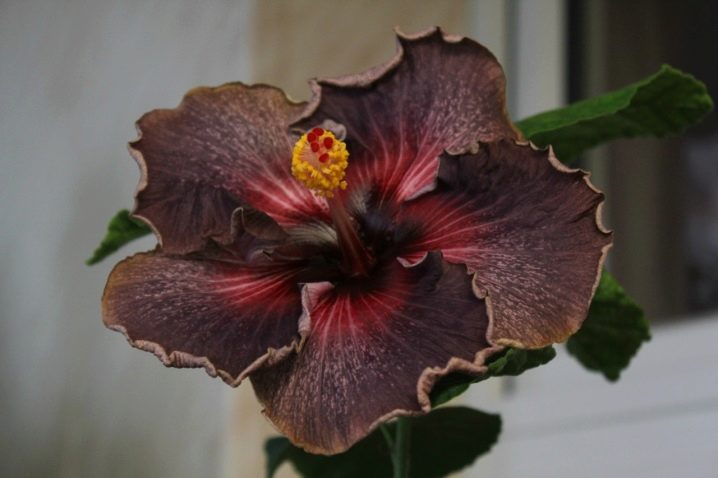
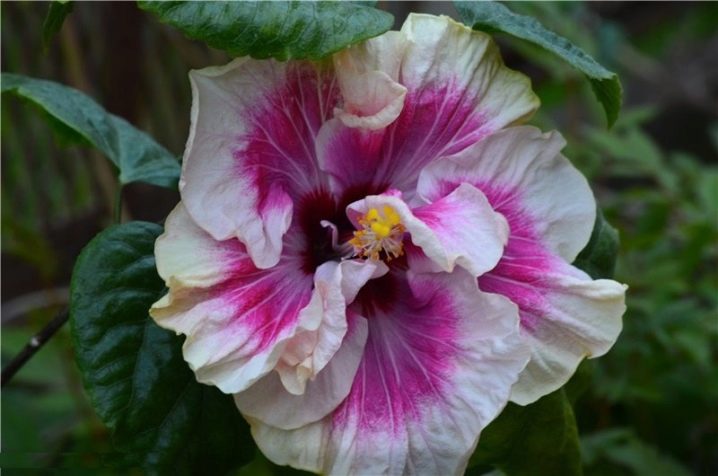
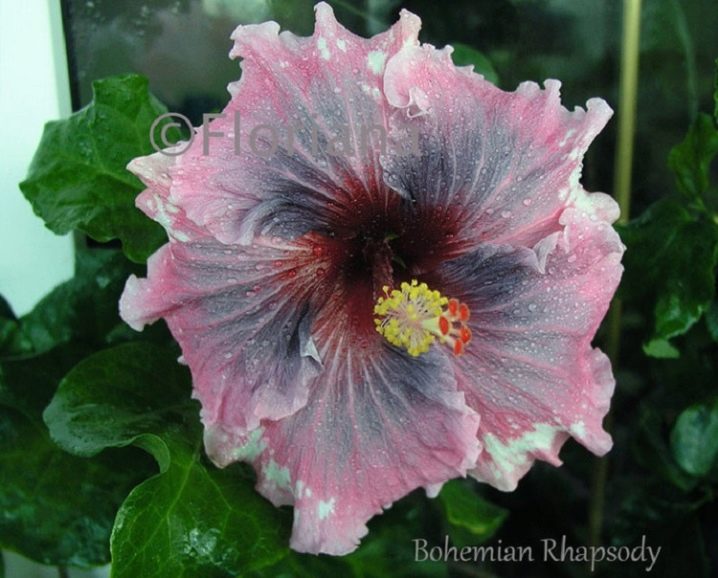
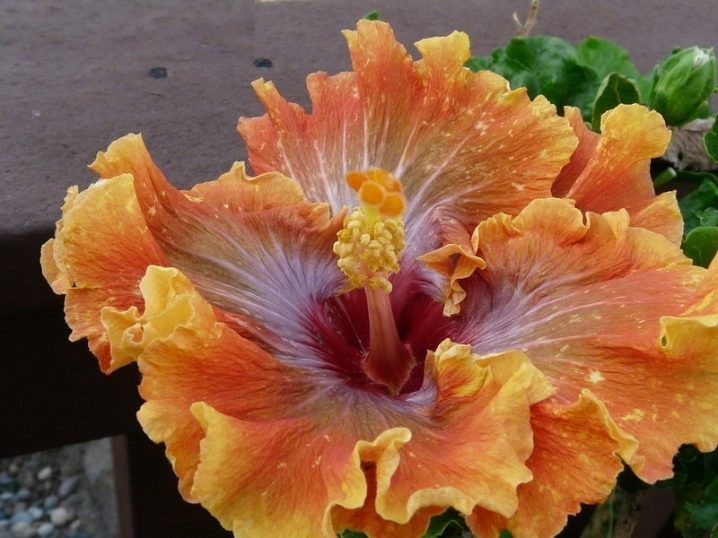
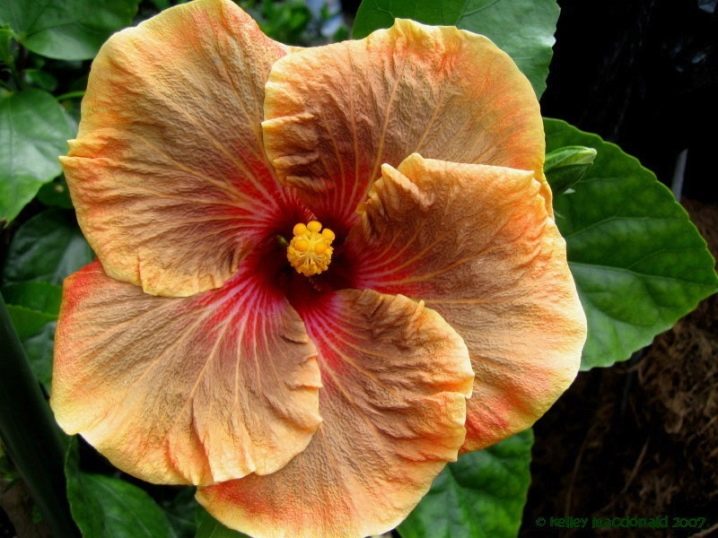
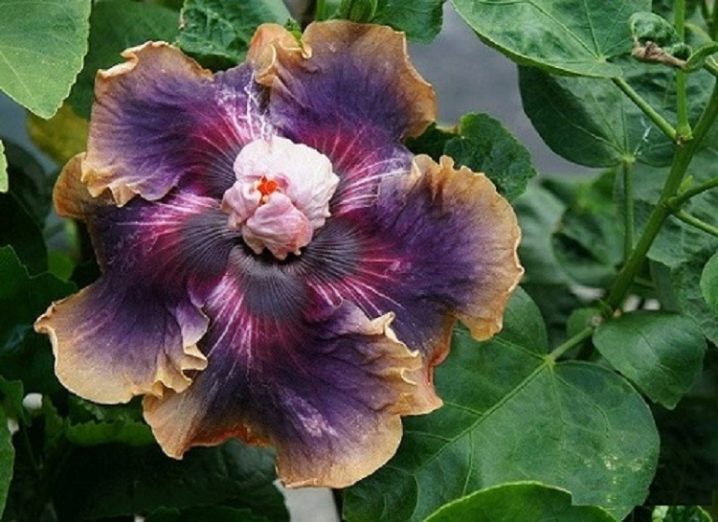
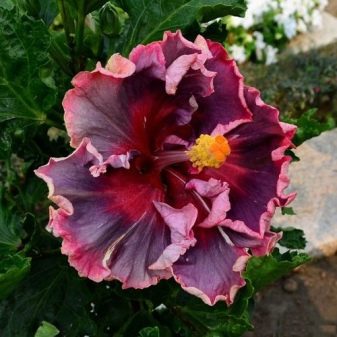

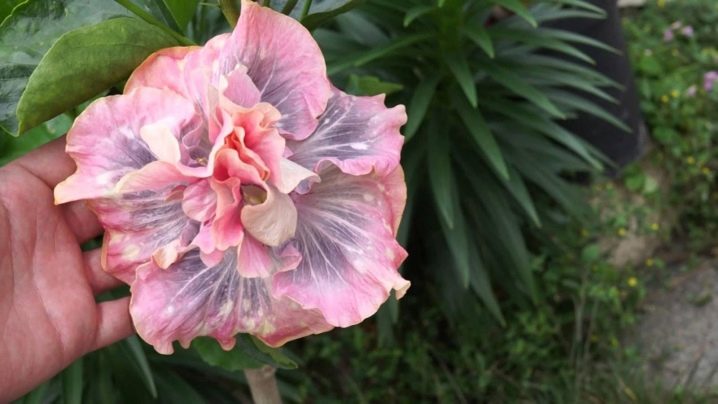

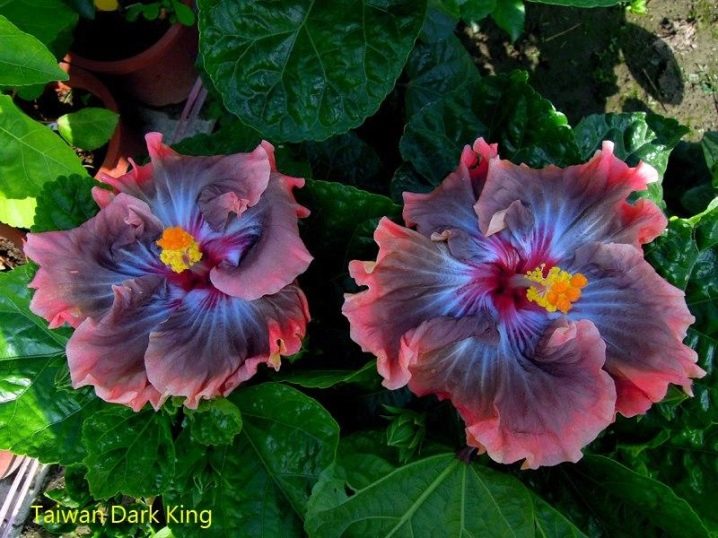
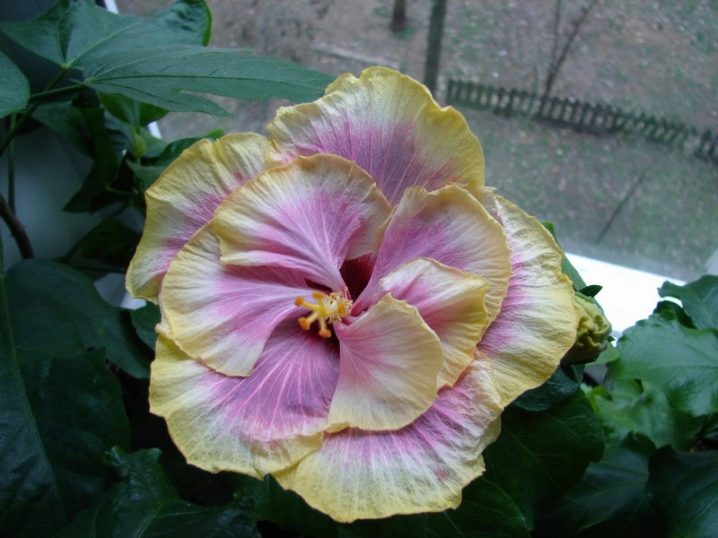
Of course, most of the outlandish varieties are selective and exotic, especially mixed varieties of varieties, and therefore it is difficult to get them on the general sale. Nevertheless, they are worth hunting for them, because no one will have such beauty.
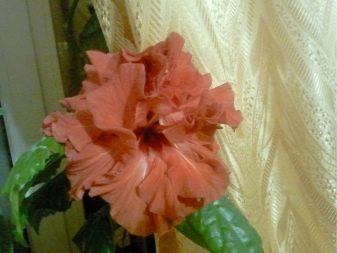
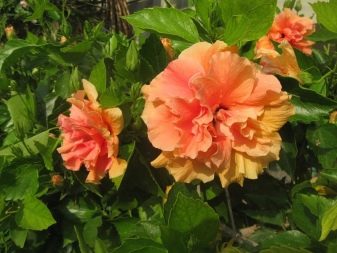
Hibiscus from Florida
For a long time, it was believed that shades of blue are not characteristic of hibiscus. Recently, however, our lovers of hibiscus have been able to obtain varieties of American selection, which have stuck with the name "Florida". The flowers are double, semi-double and simple, completely unimaginable colors - lavender, purple, lilac, brown, purple, not to mention red, pink with a transition from one color to another, with stripes or specks. In habit, they are slightly different from their usual Dutch relatives. They have a more powerful trunk, larger, more rounded and folded leaves, huge flowers - in some hybrids the diameter can reach 20-25 cm!
As a rule, flowers last only one day - they open early in the morning and wither in the late evening. True, varieties have appeared in which they remain open for 2 and 3 days. For example, the Creole Lady variety changes shades of color every day. The flowering itself lasts about 3 days: the first day the flower is very bright, on the second day the color is more restrained, on the third day it can acquire shades of gray.
Flowering continues from early spring to late autumn, and if the plant is provided with additional lighting in winter, then all year round. My collection began with the "Floridians", now it has about 60 varieties.
Florida Hibiscus Care
Practically no different from caring for an ordinary "Chinese rose". They prefer bright, diffused light, but without direct sunlight. In summer, they feel great on the western and eastern windows, and for good flowering they need abundant watering, spraying and fertilizing.
With a lack of light, they bloom poorly or completely stop flowering. If you want to admire the fabulous flowers in winter, then it is better to arrange additional lighting. Phytolamps should be placed over the plants at a distance of 50-60 cm and supplemented with light
up to 8-10 hours a day.

Reproduction of Florida hibiscus
Cuttings of many modern varieties take root poorly. Therefore, in order to get strong seedlings, they are grafted with a cuttings or buds on our usual Chinese hibiscus. The grafted plants are more hardy, grow faster and more easily acclimate to a new place.
Reproduction
In order for sour hibiscus to bloom at the end of the season, it is sown for seedlings in containers 6-8 weeks before planting in the ground. It is recommended to soak the seeds in warm water overnight before sowing. It has a positive effect on germination and scarification - damage to the outer shell of the seed, for example, by a blade.However, even without any pre-sowing treatment, the seeds germinate well.
Sow them at a shallow depth, slightly covering them with soil. Germinate in a greenhouse, keeping the soil moist, but not wet, otherwise the seeds will rot. Seeds sprout quickly, within 3-4 days (sometimes up to 2 weeks). The first cotyledonous leaves grow round and green, and the first true leaf already matches the characteristics of the variety. At this moment, the plants dive into individual containers. Seedlings are planted in late May - early June, with the end of spring frosts, without deepening the plants.
Seedlings develop quickly. It is recommended to prune the plants once so that they do not develop into one stem, while the tops can be used for cuttings that easily root in water or substrate at a temperature of + 25 ° C. Cuttings are cut into a length of 10-20 cm and half buried in the soil, which is kept constantly moist.
But pruning delays the onset of flowering
This is important, because during a cold summer, a plant in the middle lane may not have time to bloom, or form only individual flowers (this applies to the species sour hibiscus, the Mahogany variety practically does not bloom in the middle lane)
By the way, cuttings rooted at the end of summer can be stored indoors, in a greenhouse or in a basement, the flowering of these plants will be guaranteed next year.
Subspecies
Florists successfully grow several variegated hibiscus varieties.
- Hibiscus "Cooper" (Hibiscus rosa-sinensis var. Cooperi). The name was coined in honor of Daniel Cooper, who brought him to the UK from the Pacific territory of France: New Caledonia.
- Hibiscus "Carnival" (Hibiscus rosa-sinensis var. Cooperi carnival). It is dominated by pink shades in the bud.
- Hibiscus "Snowquin" or "Snowflake" with variegated leaves, and more white in its color than other species. He has leaves of a different shape, and the bush itself is small in size. During flowering, scarlet buds bloom on it.
- Hibiscus "Rose Flake". The leaves are green-white-pink, and the buds are bright scarlet.


